With the world’s population projected to reach 9.7 billion by 2050, the need for sustainable and efficient agriculture has never been greater. Traditional farming practices are not enough to meet the demands of the future. This is where vertical tomato farming comes in. Vertical tomato farming is a method of growing crops in vertically stacked layers in controlled environments. It is an efficient way to use space and resources and can be done year-round. Here are some reasons why vertical tomato farming is the future of agriculture.
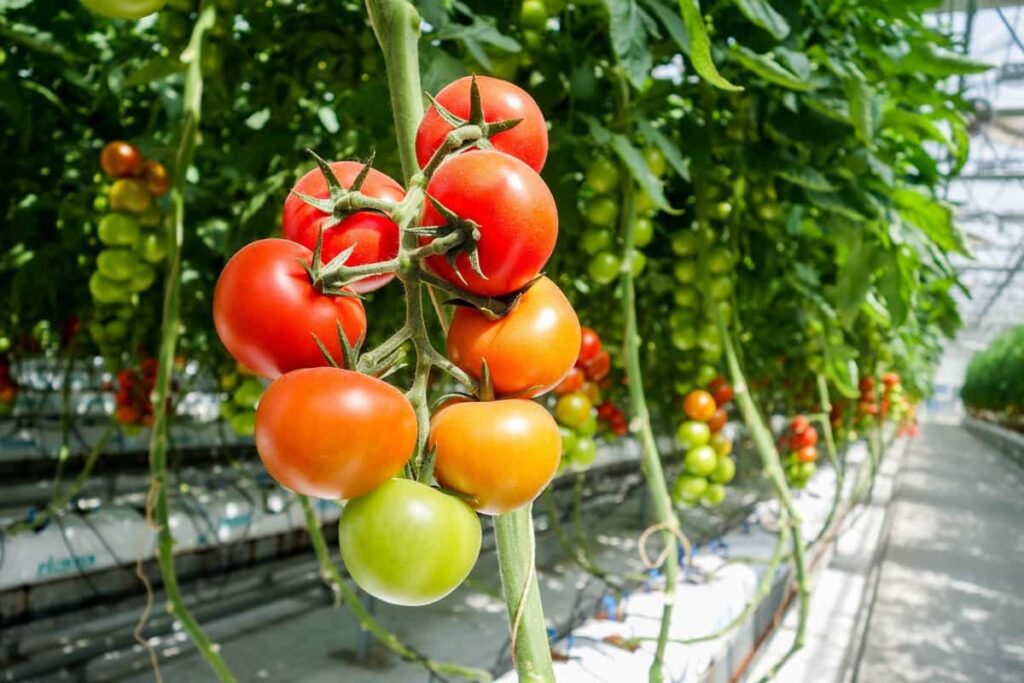
What is vertical tomato farming?
Vertical tomato farming is a type of agriculture where tomatoes are grown in vertically stacked layers in a controlled environment. This type of farming allows for higher yields per square foot and can be done using less land and water than traditional horizontal farming methods.
Why is vertical tomato farming the future of agriculture?
There are many reasons why vertical tomato farming is seen as the future of agriculture. One reason is that it is a more efficient use of land and resources. With vertical farming, less land is needed to grow the same amount of crops so that farmers can produce more food with less environmental impact. Additionally, vertical farms can be located closer to cities, which reduce transportation costs and emissions.
Another reason why vertical tomato farming is seen as the future of agriculture is that it can be done indoors under controlled conditions. This means that farmers can grow crops year-round, regardless of the weather outside. Additionally, vertical farms can be designed to use less water than traditional farms, which is essential in areas where water resources are limited.
In case you missed it: How to Grow Tomatoes in Australia from Seed: Best Time to Plant in Pots, the Backyard at Home for Sydney, Melbourne, and Victoria
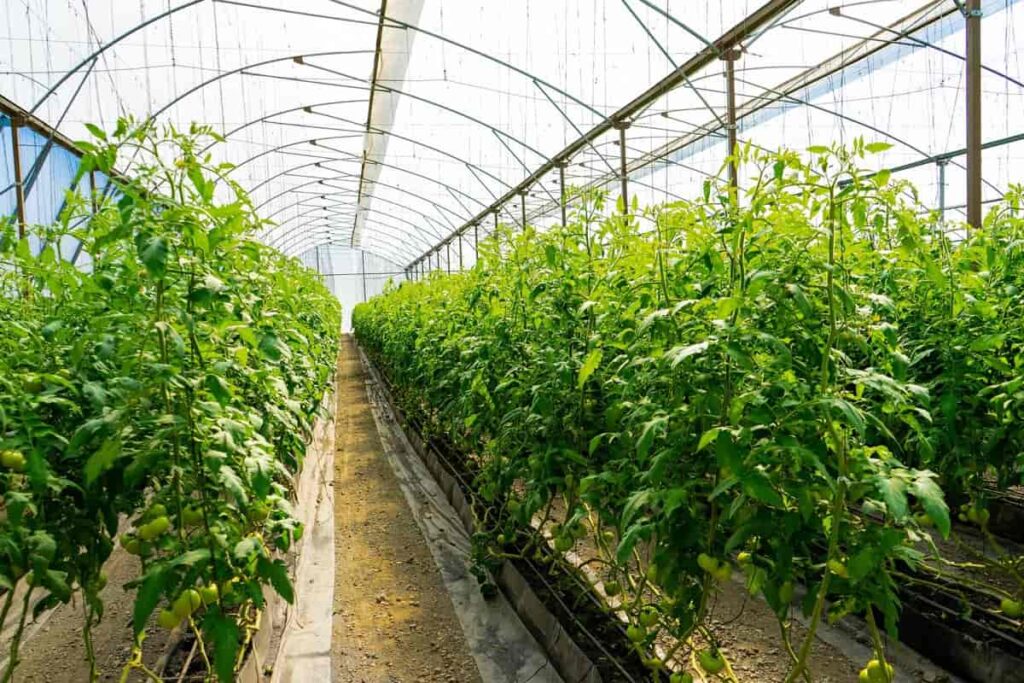
Benefits of vertical tomato farming
- Vertical tomato farming can increase yield per square foot
- Tomato plants grown vertically are less likely to succumb to pests and disease
- Vertical tomato production can save water by using hydroponic techniques
- Growing tomatoes vertically can improve air circulation around the plants, leading to better fruit production
- Farming tomatoes vertically can make it easier to harvest the crop
Drawbacks of vertical tomato farming
With the world’s population set to exceed 9 billion by 2050, the demand for food will continue to rise. Farmers will need to produce more food with fewer resources to meet this demand. The best way they can do this is by vertically farming tomatoes. However, there are some drawbacks to vertical tomato farming. For one, it is a capital-intensive endeavor.
Farmers must invest in expensive equipment and infrastructure, such as grow lights and climate control systems. Additionally, vertical farms require a lot of electricity to operate, which can drive up costs. Moreover, vertical farms can be challenging to maintain. Because crops are grown close to one another, pests and diseases can spread quickly throughout a farm. This can lead to widespread crop loss and make it difficult for farmers to control infestations.
Finally, vertical farms typically produce lower yields than traditional farms. This is because plants grown on vertically stacked shelves often have restricted root growth and receive less sunlight than those grown in open fields. As a result, farmers may not be able to meet the high demand for tomatoes if they switch to vertical farming methods.
The future of vertical tomato farming
The future of tomato farming is vertical. This farming takes up less space and can be done in urban areas. There are many reasons why this is the future of agriculture.
In case you missed it: Roma Tomato Growing Guide: For Pots, Ground, Raised Beds, and Buckets
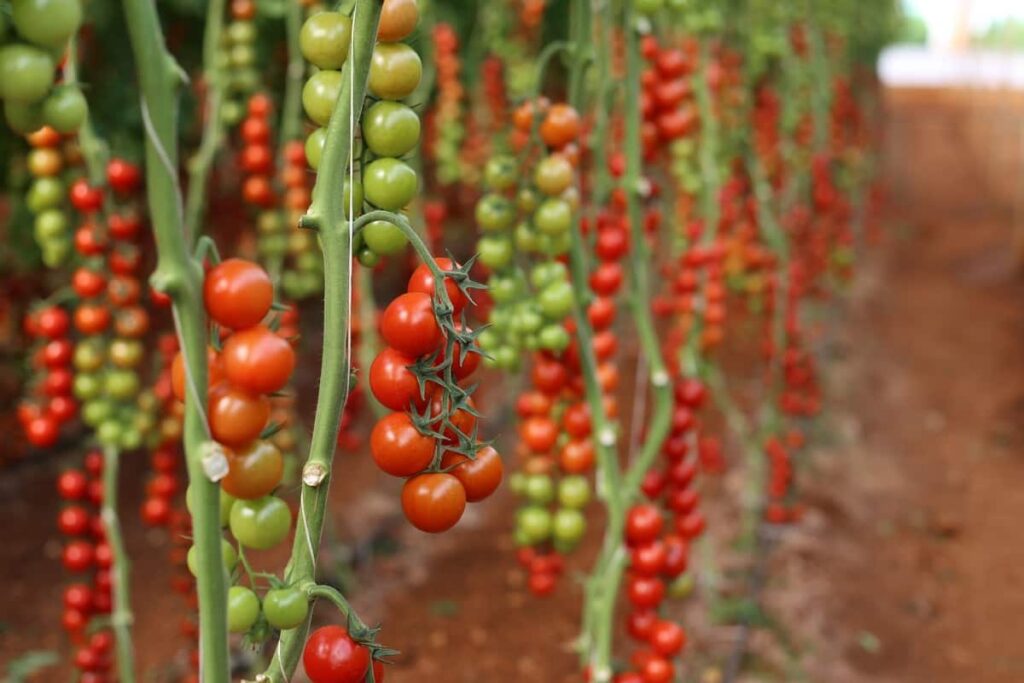
Less land needed
With vertical farming, less land is needed to grow the same amount of crops. This is because the crops are grown in layers in a tall building. This means that farmers can use less land to grow more crops.
More crops per square foot
Vertical farming also allows farmers to grow more crops per square foot. It is because crops are grown in a controlled environment with access to the perfect amount of light, water, and nutrients.
No pesticides needed
Another benefit of vertical farming is that no pesticides are needed to protect the crops from pests. This is because the crops are grown indoors in a controlled environment where pests cannot reach them.
How to set up a vertical tomato farm
If you are looking for a new way to garden that is sustainable and efficient, then vertical tomato farming may be for you. This type of gardening is perfect for those with limited space, as it allows you to grow many tomatoes in a small area. Plus, it is a great way to get the most out of sun exposure and water usage. Here is some information you need to know about setting up a vertical tomato farm:
Choose the perfect location
Vertical tomato farming can be done in any weather, but choosing a spot with at least 6 hours of sunlight per day is best. If you live in an area with scorching summers, you may want to consider adding shading to your farm so that your tomatoes do not overheat.
Decide on the type of system you want to use
Many types of vertical tomato farming systems are available on the market, so do some research and decide which will work best for your needs. Some systems are more accessible to set up than others, so keep that in mind when making your decision.
In case you missed it: How to Grow Cherry Tomatoes at Home: from Seeds and Tomatoes in Pots, Indoors, and Planting, Care
Gather your supplies
Once you have chosen a location and system, it is time to gather all the necessary supplies. These include tomato cages, support stakes, soil, mulch, and plants. Make sure to get high-quality products so your farm will last for years.
How to grow tomatoes vertically
Growing tomatoes vertically is a great way to maximize your garden space if you’re limited in space. Training tomatoes to grow support will free up valuable space in your garden for other plants. Plus, vertical tomato plants are easier to care for and less likely to succumb to pests and diseases. Here are some tips for growing tomatoes vertically:
- Choose a compact tomato variety. Wide varieties of dwarf or determinate tomatoes are well suited for growing vertically.
- Install a sturdy support system. Tomatoes can get heavy, so make sure your support system is strong enough to hold them up. A simple trellis made from bamboo or metal stakes will work well.
- Train the plants as they grow. As the tomato plants grow, gently guide them onto the supports. Use twine or soft ties to secure them in place if necessary.
- Pinch off-side shoots. Side shoots typically form at the leaf joints along the plant’s stem. These side shoots should be pinched off regularly to encourage vertical growth and prevent the plant from becoming too bushy.
- Water regularly and fertilize monthly. Water your tomato plants deeply and regularly, especially during hot weather. Fertilize with a balanced fertilizer monthly to promote healthy growth.
Tips for successful vertical tomato farming
With the ever-growing popularity of urban gardening, more and more people are looking for ways to grow their food in small spaces. Vertical farming is one way to do this, and it’s especially well-suited for tomatoes. Here are some tips for successful vertical tomato farming:
- Choose a suitable variety of tomatoes for your climate and space. Some varieties are better suited to vertical growing than others. Do your research and pick a variety that will do well in your area.
- Prepare your soil well: Tomatoes need rich, fertile soil to thrive. Amend your soil with compost or other organic matter before planting to give your plants a good start.
- Start with healthy plants: Whether you’re starting from seed or purchasing seedlings, make sure they are healthy and vigorous before planting them in your garden.
- Provide adequate support for your plants: Tomato plants can get heavy when laden with fruit, so make sure they have plenty of support to prevent them from toppling over. Stakes or cages work well for this purpose.
- Protect your plants from pests and diseases: Keep an eye out for their signs and take steps to control them immediately. Check with your local extension service for pest control recommendations specific to your area.
- Harvest regularly: Pick tomatoes when they’re ripe and keep up with harvesting so the plant continues producing fruit all season.
In case you missed it: High Yield Hybrid Tomato Varieties in India: For Winter, Summer, and Rainy Season
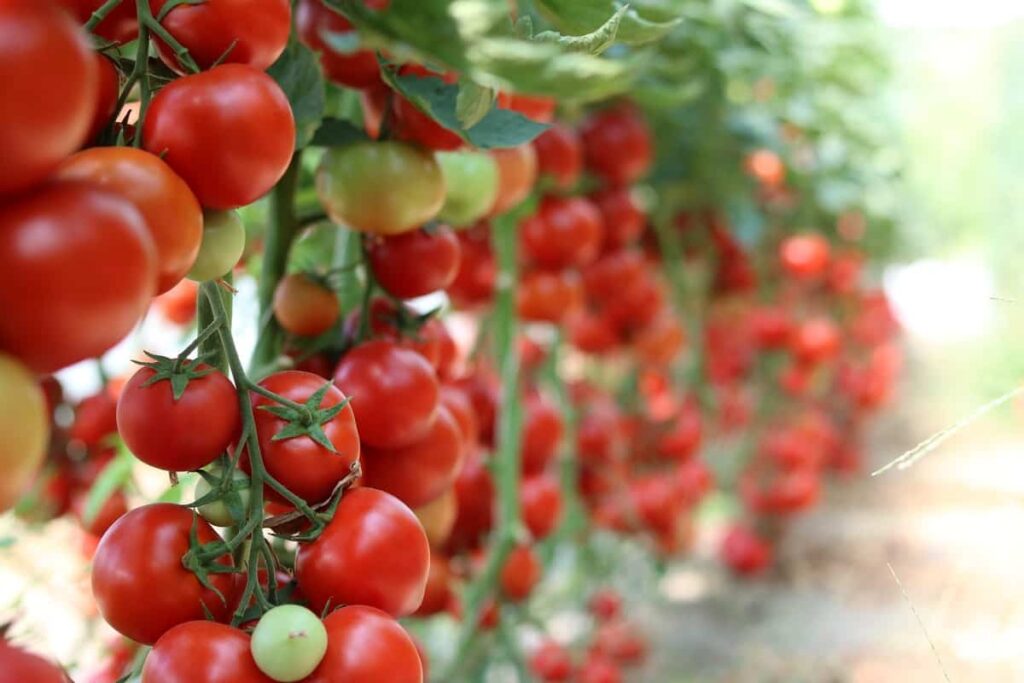
Hydroponic Vertical Tomato Farming
Hydroponic vertical tomato farming is a type of agriculture where tomatoes are grown on vertically stacked shelves in a soilless medium, typically with a water-based nutrient solution. This type of farming allows for a higher density of tomato plants and can be used indoors and outdoors. Advantages of hydroponic vertical tomato farming include:
- Increased yield per square foot: By growing plants vertically, more plants can be grown in the same space as traditional horizontal farming methods.
- Reduced water usage: Since the roots are constantly exposed to moisture, water evaporation is less than the traditional farming methods.
- Pest and disease control: When done correctly, hydroponic systems can create a sterile environment that is less likely to harbor pests and diseases.
- Year-round production: With proper temperature and light control, hydroponic vertical tomato farms can produce tomatoes year-round, even in climates where it is not traditionally possible to grow them outdoors.
- Space savings: Hydroponic vertical tomato farms can be built vertically, saving valuable ground space.
Greenhouse vertical tomato farming
Vertical tomato farming in greenhouses is a space-efficient way to produce many tomatoes. Farmers can increase their yield per square foot by growing tomatoes vertically and reducing their overall water usage. Tomatoes are a high-value crop, so farmers who can maximize their production will be more successful. Vertical tomato farming allows farmers to do just that.
Farmers can take advantage of otherwise unused space in their greenhouses by growing plants up instead of out. Not only does vertical tomato farming increase production, but it also reduces water usage. Because the plants are closer together, they require less water overall. This is especially important in regions where water is scarce. Vertical tomato farming is an excellent option if you’re a greenhouse farmer looking to increase your production. With its space-saving and water-saving benefits, it’s an option worth considering.
In case you missed it: Vertical Tomato Farming: Modern Way of Getting More Yields in Less Space
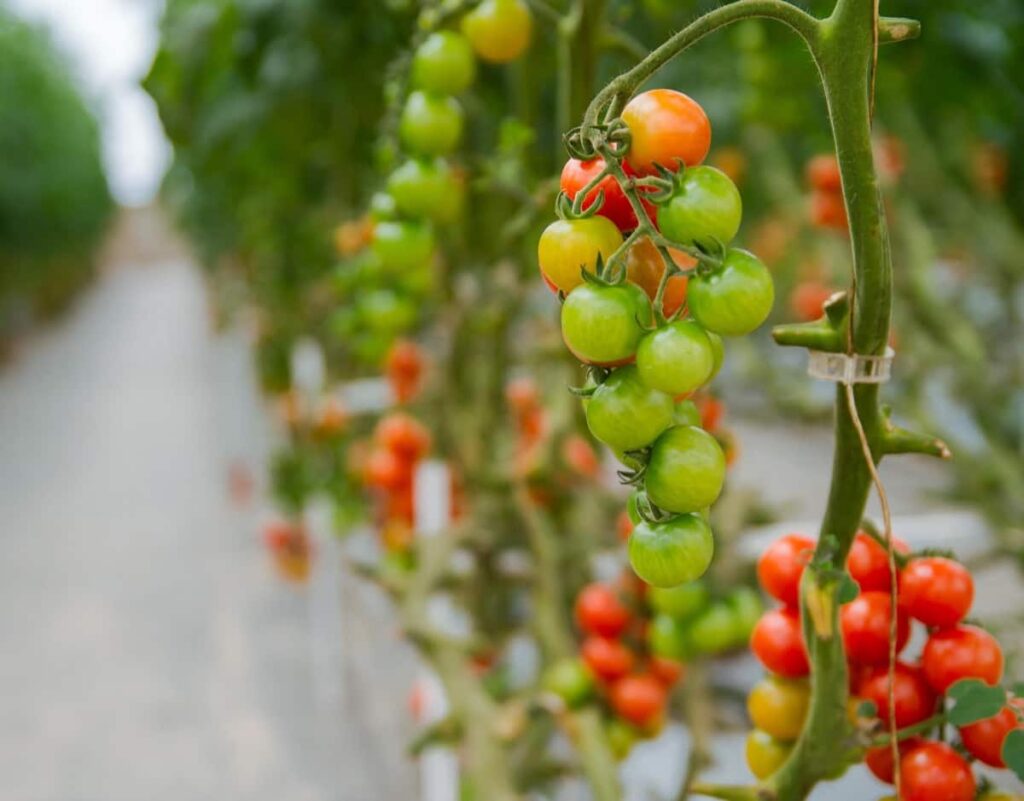
Conclusion
Vertical tomato farming has a lot of advantages over traditional methods of growing tomatoes. Not only is it more efficient in terms of land usage, but it also results in higher yields and healthier plants. Additionally, vertical tomato farms are less likely to be affected by pests and diseases, and they can be easily automated. With all of these benefits, it is no wonder that vertical tomato farming is quickly becoming the future of agriculture.
- Profitable Village Farming Business Ideas in 2024
- High-Yield Aquaculture: Fast-Growing Fish for Farming
- Effective Fish Pond Construction Techniques for Beginners
- Irrigation and Water Management in Pineapple Farming
- Blossom to Harvest: Mastering Flowering and Pollination in Papaya Farming
- Pig Fattening Essentials: From Selection to Sale for Beginners
- Raising Wagyu Cattle: A Complete Guide for Premium Beef Production
- Soil Types and Their Water Holding Capacity
- Optimizing Irrigation Schedules for Coconut Groves for Enhanced Yield
- Espresso Your Garden: Coffee Grounds for Healthier Acid-Loving Plants
- The Best Soil Mix for Snake Plants: How to Mix Your Own Snake Plant Soil
- Green Thumb Success: Expert Tips for Cultivating Greenhouse Beans All Year Round
- Bloom All Year Round: The Ultimate Guide to Indoor Hyacinth Care
- Eco-Friendly Gardening: How to Make Liquid Fertilizer from Kitchen Waste
- Ultimate Guide to Grow Anise in Pots: Explore Seed Propagation to Harvesting
- Guide to Raising Chester White Pigs: Discover Breed Facts to Growth Management
- Mastering the Elegance: The Ultimate Guide to Weeping Cherry Tree Care, Planting, and Maintenance
- Ultimate Guide to Planting Garlic in Grow Bags: Growing Strategies for Beginners
- How to Fix Spider Plant Leaf-Related Problems: Natural and Organic Remedies
- 10 Reasons Why Your Tulsi Plant is Shedding Leaves: Home Remedies and Solutions
- Optimizing Growth and Yield: The Advantages of Palm Bunch Ash Fertilizer
- Utilizing Neem Oil Extract as a Natural Pesticide for Hydrangea
- From Soil to Harvest: Various Ways in Which Farmers Can Use AI Tools
- Steps to Encourage and Induce Citrus Flowers: A Comprehensive Guide
- How to Fix Snake Plant Leaf-Related Issues: Natural and Organic Remedies
- Transform Your Garden into a Fragrant Oasis with Raat Ki Rani (Night Blooming Jasmine)
- Discover the Ideal Chicken Breeds for Philippine Farms
- How to Create a Poultry Egg Farm Business Plan for Profits
- Grow Lemon Cucumbers Like a Pro: Insider Techniques for Bountiful Yields
- Ultimate Guide to Caring for Your Pink Princess Philodendron: Tips for Thriving Variegation
- Areca Nut Profit Per Acre: Calculating Yield and Cost of Cultivation
- How Kaveri Chicken is Becoming a More Profitable Breed in Indian Backyards
- Transform Your Barn: 9 Steps to Convert a Horse Stall into a Chicken Coop
- Exploring Suffolk Sheep Disadvantages with Limitations and Challenges
- Guide to Solving Potted Lemon Tree Problems: How to Revive Lemon Tree in Containers
- Steps to Encourage Female Pumpkin Flowers: Best Strategies for More Flowers and High Yields

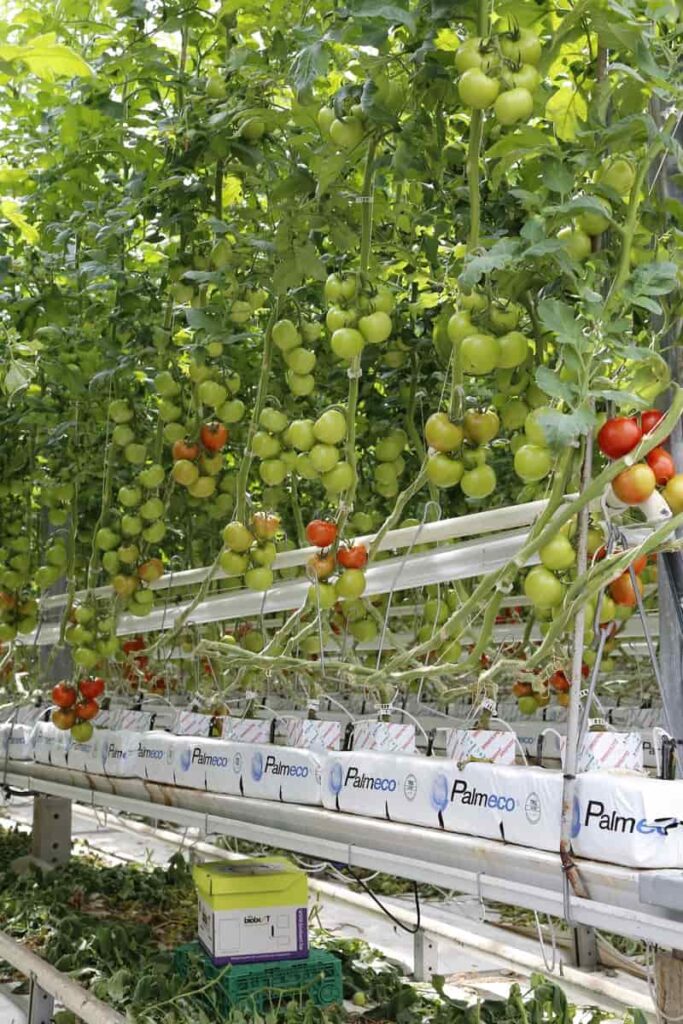
Very informative stuff